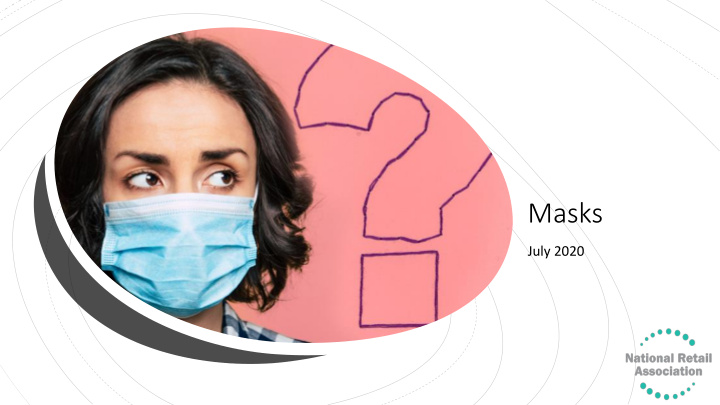



Masks July 2020
Rules and Recommendations • If you live within metropolitan Melbourne or Mitchell Shire, you must wear a face covering whenever you leave your home, unless an exception applies. A face covering needs to cover both your nose and mouth. It could be a face mask or shield. • From 11.59pm Wednesday 22 July 2020 • N95 respirators, surgical masks or reusable face coverings. Face shields. • The Chief Health Officer recommends a cloth mask made of three layers of a mix of breathable fabrics to ensure adequate protection. • Read more: https://www.dhhs.vic.gov.au/face-masks-covid-19
What is best for our team? • Make disposable masks available. • Provide clear guidance on how to use a masks properly – if you can make a video. • Allow suitable reusable masks. • Provide guidance on appropriate use and care of reusable masks. • Provide guidance on how to deal with customers. Ensure staff are not subject to aggressive behaviour. • Consult your legal counsel as needed.
Using a mask : • Ensure your hands are clean by washing with soap and water for 20 seconds, and then dry your hands before putting on a mask. If washing your hands is not possible, then use alcohol-based hand sanitiser as an alternative. • To fit the mask, ensure you have the correct side facing outwards (typically the coloured side) and find the nose piece to locate the top of the mask. Place the nose piece over the bridge of the nose, place the elastic over the ears or tie at the back of the head. Cover your nose and mouth and ensure it fits under the chin ensuring there are no gaps. • Avoid touching the mask while using it. If you do touch it, clean your hands with alcohol -based hand sanitiser or soap and water. • Replace the mask with a new one as soon as it becomes soiled, dirty or damp and do not re -use single-use masks. Do not share masks with anyone else. • You should also change the mask after your breaks and during a long shift. Removing and disposal of mask : • Hold the edge of the earpieces or straps attached to take off the mask and do not touch the inside part of the mask. • Gently remove the mask and dispose into a closed bin. • After disposal, clean hands with soap and water for 20 seconds. If washing hands is not possible use alcohol -based sanitiser as an alternative. Video by the Australian Government Department of Health ‘How to wear a mask’
Sourcing Masks • Ensure you purchase from a trusted supplier. • Having an ARTG listing is preferable, but not a must: Non-sterile face masks that are designed as safety or protective apparel for use in the home or for recreational or occupational use are excluded from regulation by the TGA. There cannot be any misleading claims (packaging / advertising). • Sight all relevant test reports – these should be from an approved laboratory and include all relevant clauses of the respective standard. • Check if the factory us white listed by CCCMHPIE, China. • Ensure the same manufacturer is stated on all documents provided to you. • Ask for samples and review these. • Ask for a final inspection report from a trusted 3 rd party. • Keep a compliance folder!
ARTG Listing and TGA Recommendations • Check the Australian Register of Therapeutic Goods (ARTG) • Check the post-market review of face masks: Cancelled ARTG entries • Check TGA advice on surgical masks and gowns during COVID-19 • Check Product Safety Australia on COVID-19: Supplying face masks Standards for Masks • United States ASTM Standards • • N95 - United States NIOSH-42CFR84 Europe EN 14683:2014 • • FFP2 - Europe EN 149-2001 China GB/T 32610-2016 / YY 0469-2011 • • KN95 - China GB2626-2006 Australia AS 4381:2015 • P2 - Australia/New Zealand AS/NZS 1716:2012 NOTE: This is only a selection of commonly used standards. Check standards that are referenced in test reports for their suitability.
White Lists – Export of PPR from China China Chamber of Commerce for Import & Export of Medicines & Health Products Name List of Medical Devices and Supplies Companies with Certification/Authorization from other Countries • http://en.cccmhpie.org.cn/Web/Content.aspx?queryStr=w7x08q7x15x15o3w8w1vS9z8w7x1X10x16x0X10x16o3w8w1u9v1u 9v3v2v3 Name List of Non-Medical Use Face Masks Companies with Certification/Authorization from other Countries • http://en.cccmhpie.org.cn/Web/Content.aspx?queryStr=w7x08q7x15x15o3w8w1vS9z8w7x1X10x16x0X10x16o3w8w1u9v1u 9v3v2v7 National Medical Products Administration (NMPA), China List of NMAP-approved Manufacturers of PPE and Medical Devices • http://en.cccmhpie.org.cn/Web/Content.aspx?queryStr=w7x1X10x16x0X10x16o3w8w1u9v1u9v3v0v7z8w7x08q7x15x15o3w 8w1vS9z8p0w7x08q7x15x15o3w8w1 China National Accreditation Service for Conformity Assessment (CNAS) Laboratories Accredited by CNAS for Testing of Masks, Gloves, Medical Protective Clothing and Other Personal Protective Equipment • https://www.cnas.org.cn/english/photonews/06/903064.shtml
Reusable Textile Face Coverings • A cloth mask made of three layers of a mix of breathable fabrics to ensure adequate protection. • Ideally machine washable at 60°C. • To come with a care label attached and user instructions. • With extended skin contact fabrics must be free of harmful chemicals (i.e. tested to REACH). • The Olson Mask (named after 1930s nurse Lyla Mae Olson) is one of the most common contoured mask pattern.
https://lovin.ie/entertainment/h ilarious-sign-encourages-public- to-treat-your-mask-like- underwear
Recommend
More recommend